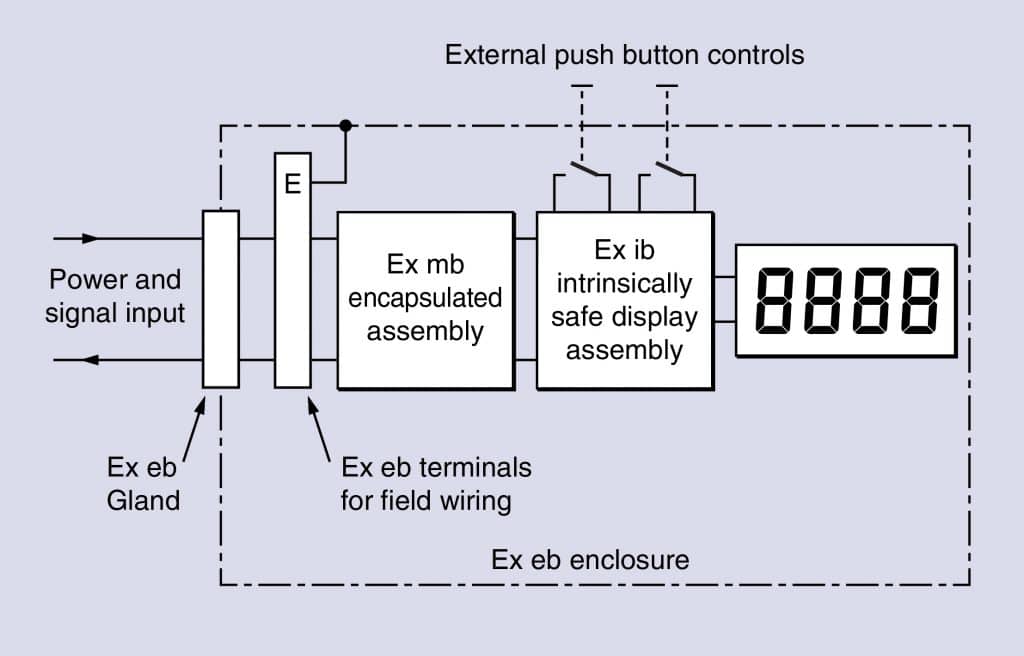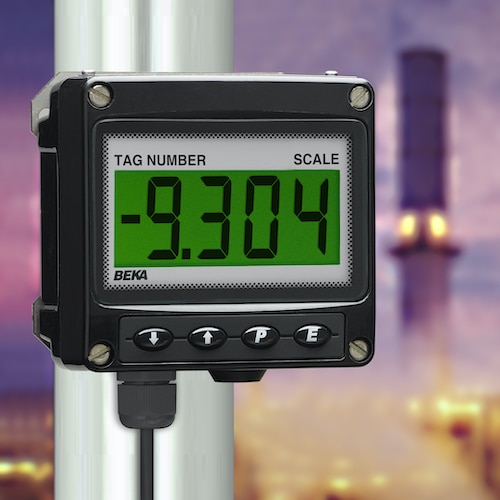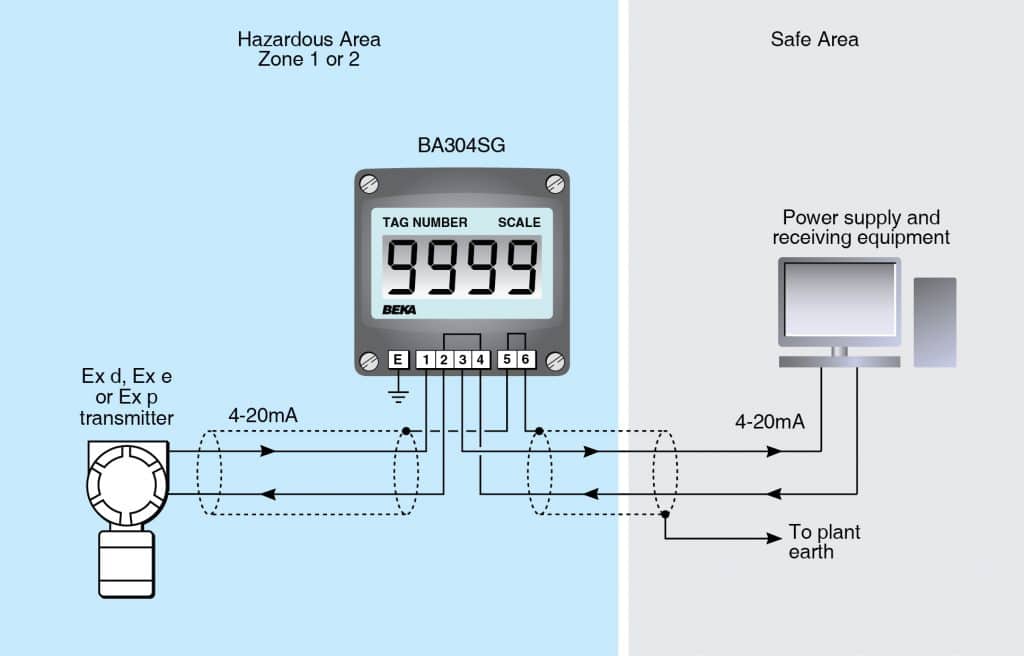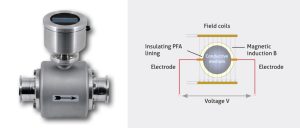![]()
BEKA has always promoted intrinsically safe display instrumentation for applications in Zone 1, but there are a significant number of users who prefer other explosion protection techniques, particularly flameproof Ex d instrumentation.
Flameproof instruments do not require Zener barriers or galvanic isolators and they do not involve users with the perceived complexity of entity and cable parameters. However, flameproof enclosures do not lend themselves to accommodating large windows through which a display can be easily seen and they tend to be heavy and expensive. BEKA has therefore developed an alternative approach to Zone 1 display instrumentation which overcomes both the complexity of intrinsic safety and the limitations of flameproof instrumentation.

Increased safety Ex e
Increased safety Ex e is an explosion protection technique which when applied to electrical equipment provides increased security against the possibility of excessive temperatures and against the occurrence of arcs and sparks. It has traditionally been used for protecting Zone 1 and 2 electrical machines, luminaires, trace heating and terminal enclosures. Until recently, Ex e has rarely been used for protecting low power instrumentation. However the latest edition of the IEC increased safety standard IEC 60079-7:2015 introduced two levels of protection:
Ex ec (Equipment Protection Level EPL ‘Gc’) – For applications in Zone 2
Intended as replacement for Ex nA.Electronic components such as semiconductors and capacitors may be used.
Ex eb (Equipment Protection Level EPL ‘Gb’) – For applications in Zone 1 and 2
Excludes the use of electronic components such as semiconductors and capacitors.
Ex e increased safety relies heavily on the integrity of the equipment enclosure to protect the electrical equipment within the enclosure, but the explosive atmosphere is not excluded from the enclosure. To ensure that safety is maintained in an industrial environment during the lifetime of the product, the standard requires enclosures to provide ingress protection after impact testing. Additionally, IEC standards require non-metallic enclosures to be subjected to lengthy high and low temperature thermal endurance at high humidity prior to impact and ingress testing.

Moulded GRP (glass reinforced polyester) enclosures complying with increased safety requirements have been successfully used for terminal enclosures for many years. Ex eb compliant GRP instrument enclosures can be designed to accommodate a large window with less difficulty than fitting a similar sized window in a flameproof Ex d enclosure. Both flameproof Ex d and increased safety Ex eb enclosures may be installed in Zone 1, but moulded GRP enclosures are less expensive to manufacture and tend to be lighter than the equivalent flameproof metallic enclosure. However, electronic components within an Ex eb enclosure require additional explosion protection.
The BEKA alternative Zone 1 design
The BEKA alternative Zone 1 instrument design uses two additional explosion protection techniques, encapsulation Ex m and intrinsic safety Ex i, to protect the electronic components within a moulded GRP increased safety Ex eb enclosure. Figure 1 shows the resulting instrument structure.
An increased safety enclosure provides IP66 environmental and impact protection for the display assembly and for the Ex e approved terminals that connect the field wiring to the instrument. Unlike a traditional metallic flameproof enclosure, increased safety Ex e certification requirements enable the moulded GRP enclosure to have a large display window and an elastomeric keypad which activates internal switches for control and calibration while the instrument is in the hazardous area.
The BEKA increased safety Ex e enclosure
The BEKA glass reinforced plastic (GRP) enclosure is very robust and provides similar mechanical and ingress protection as a conventional metal flameproof enclosure. Two thirds of the enclosure front is occupied by a thick rectangular toughened glass window through which a large display can easily be seen. The enclosure has been awarded increased safety Ex eb component certification following successful completion of thermal endurance testing for 28 days at 85∫C and 90% relative humidity, followed by a shorter exposure at -45∫C. These enclosures were then subjected to 7J impacting at both high and low temperatures, prior to ingress testing which confirmed that they still provided IP66 water and dust ingress protection. The BEKA Ex e enclosure is suitable for installation in most industrial environments and has been used in many thousands of successful industrial installations.
Additional explosion protection
Electronic components are not permitted within an Ex eb enclosure installed in Zone 1 without additional protection, which may be provided by any Zone 1 explosion protection method such as encapsulation. To provide maximum flexibility, the new BEKA alternative instrument design employs two techniques. Energy limiting components are mounted within an encapsulated Ex mb assembly with an intrinsically safe Ex ib output. This encapsulation prevents a potentially flammable gas atmosphere accessing the energy limiting components and the intrinsically safe output is nonincendive allowing a wide range of electronic components to be connected.

The instrument display, associated electronics and the push button switches are connected to the intrinsically safe output from the encapsulated assembly. The capacitance and inductance within these circuits comply with hydrogen IIC intrinsic safety limits, and power is limited to prevent excessive surface temperatures, therefore the circuits remain safe even under fault conditions.
This alternative design, which uses multiple well established existing explosion protection techniques, is applicable to a wide range of display instrumentation for installation in Zone 1 and Zone 2. It is less expensive than a traditional flameproof Ex d instrument, it allows a much larger display to be incorporated and has tactile push button controls which can be operated in the hazardous area. The alternative instrument only requires Ex eb glands for sealing field wiring entries and complies with flameproof Ex d installation requirements.
First new models
Initially BEKA have used this combined explosion protection technique to extend it’s range of loop powered 4-20mA indicators as shown in Fig 2, but the technique is applicable to a wide range of display instrumentation. The BA304SG has four 34mm high digits and the BA324SG has five 29mm high digits plus a 31 segment bargraph. Both these IECEx and ATEX certified indicators can be used as shown in Figure 3. They are lower cost alternatives for flameproof Ex d indicators with a much larger easy to read display and tactile controls that can be operated in the hazardous area. The new indicators may safely be connected in series with almost any 4-20mA Zone 1 or 2 loop, using any method of explosion protection, except intrinsic safety.
The new models may also be used to replace Ex nA indicators in Zone 2 when the Ex nA ATEX standard is de-harmonised, probably in 2022.
Conclusions
For users who prefer flameproof loop powered 4-20mA indicators, BEKA have developed lower cost alternative, IECEx and ATEX certified Ex eb indicators which may be installed in Zones 1 and 2 and comply with flameproof installation requirements. These alternative instruments have larger displays and tactile push buttons and may also be installed in dust hazardous areas.
BEKA have published a new Application Guide AG320 which describes the installation and use of these new alternative instruments, plus additional background information about their design.
Click here for more informationClick here for related articles and news
Subscribe to our E-Newsletters
Source of Article



